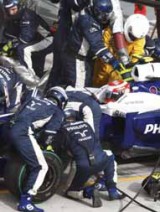Why not build on children’s interest in motor racing to develop their groupworking and persuasive skills?
This year’s Formula One season has been one of the most exciting ever, with British driver Jenson Button following in the tyre-tracks of Lewis Hamilton by winning the driver’s championship. But while Button might hog the headlines, to be successful, a Formula One team requires a wide range of skills, from an expert knowledge of aerodynamics to the ability to persuade sponsors to support the team financially. Formula One therefore offers an excellent opportunity to develop children’s skills in a wide variety of areas. Here we look at two in particular – group-working and persuasion.
 It can take 500 people to win one race…
It can take 500 people to win one race…
Although it’s the person at the wheel who gets all the attention, Formula One is very much a team sport, with hundreds of people working behind the scenes to make sure that it’s their driver who gets the chequered flag.
Start by finding out how much the children already know about Formula One, and see how many different teams and drivers they can name.
Show the children a photograph of a driver celebrating after a race. Explain that, although there’s only room in a Formula One car for the driver, it takes hundreds of people working together to get him over the finishing line. The Williams F1 team employs more than 500 people.
Put the children into groups of four and ask them to name as many jobs as possible in the racing team and to explain what the people in those jobs might do. Allow a few minutes for them to do this, then get answers from each team and write them up on the board. Add the following job titles to the list, if they haven’t already come up, and ask children what these people might do:
• Design engineer (uses computers to invent new car designs)
• Research engineer (tests new ideas for car designs)
• Production department worker (produces car parts in the team factory)
• Mechanic (puts car parts together and repairs cars)
• Marketing person (gains sponsors and communicates with the media).
 What happens if one person doesn’t pull his weight…
What happens if one person doesn’t pull his weight…
Explain to the children that every single member of the team is vitally important, and that each one needs to do his or her job well for the driver to have a chance of winning the race. Ask the children to work again in their teams, choosing four of the different jobs and considering what might happen if that person doesn’t do his job properly. When they’ve done this, get eachteam to choose one of these scenarios to act out in front of the class.
Finally, explain to the children that working in their groups in class (as, for instance, on the task they’ve just completed) is just like working together in a Formula One team: everyone has a different job and needs to do it well for the team to be successful.
 How to raise £200 million…
How to raise £200 million…
Ask the children to estimate how much it costs each year to run a Formula One team (an average team spends up to £200 million). Ask the children to suggest some reasons why running a team should cost so much money. Answers might include paying staff (including rivers); attending races all over the world; and researching, designing and building the car.
Now explain to children that three of the most important ways that a Formula One team can make money are from merchandise (caps, T shirts and so on), selling television rights, and sponsorship from other companies. Draw a pie chart on the board and ask children to suggest how much of the pie comes from each type of income (in fact around 70% of a team’s income comes from sponsorship).
Show the children the photograph of a racing car, and ask them whether they recognise any of the names written on it. Explain that all these names belong to companies who sponsor the team. For example, point out the name ‘Philips’ on a Williams car, and ask if anyone knows what sort of company Philips is (Philips manufacture TVs, MP3 players, electric shavers and toothbrushes).
Ask children to suggest why Philips might want to sponsor the Williams F1 team. Answers might include the following: to link up with another hi-tech company; to advertise their products to potential customers, e.g. many Formula One fans are men who might choose to purchase a Philips shaver after seeing the brand name on a Formula One car
 Persuede potential backers you’ve got the right stuff…
Persuede potential backers you’ve got the right stuff…
Explain that teams have to make Dragon’s Den-style ‘pitches’ to potential sponsors (find out how to set this up on pages 52-53). In that pitch, they need to put across the reasons why the sponsor would benefit from supporting their team. Split the children into teams and ask them to produce a one-minute pitch to persuade a company to sponsor their own imaginary Formula One team.
Assign to each team one of the following types of company (airline company; computer game manufacturer; petrol company). Before they prepare their presentations, give the teams a few minutes to think of reasons why the sponsors would want to sponsor them, and persuade them that they’re the best choice.
After each team within a category (airline company; computer game manufacturer; petrol company) has made their presentation, ask the class to vote for which team has been most persuasive.
After all the presentations are over, ask each team to judge how effectively they worked together: whether they listened to, and valued, each other’s ideas; whether they carried out their individual roles effectively, and whether everyone contributed.
All the material here is taken from Race to Learn, a new cross-curricular product for the IWB, published by Cambridge University Press and Williams F1. Race to Learn contains teaching materials for twelve half-day sessions covering a wide variety of curriculum areas, all closely linked to National Curriculum objectives. Children work in teams, developing their groupworking skills within the engaging real-life context of Formula One racing. Visit http://www.racetolearn.org for more details.
Pie Corbett’s bike poems
Topic
